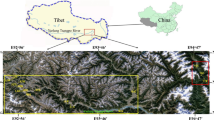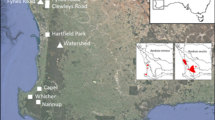Abstract
The fine-scale clonal structure in the patch of the invasive plant Mikania micrantha H.B.K. and its plant parasite Cuscuta campestris Yunker were investigated by distinguishing genets using ISSR markers. A high level of clonal diversity (G/N = 0.7, D = 0.9579, E = 0.7778) in M. micrantha and a low level of clonal diversity (G/N = 0.2, D = 0.7632, E = 0.9479) in C. campestris might be due to the different reproductive strategies, different migration rates and different number of founder. Clonal composition of M. micrantha (14 genets of 20 ramets) and C. campestris (4 genets of 20 ramets) were significantly different. There was no relationship between host and parasite genetic distance matrices using Mantel test (r = 0.073, P = 0.150). Spatial autocorrelation analysis of M. micrantha showed that the correlation value was positive and significant at 2 m with an x-intercept of 3.5 and 4.0 m for distance class sizes of 1 and 2 m, respectively. Spatial autocorrelation analysis of C. campestris showed that the correlation value was positive and significant at 2 m and significantly negative at 10 m with an x-intercept of 4.8 and 6.6 m for distance class sizes of 1 and 2 m, respectively.




Similar content being viewed by others
References
Auge H, Neuffer B, Erlinghagen F, Gruppe R, Brandl R (2001) Demographic and random amplified polymorphic DNA analyses reveal high levels of genetic diversity in a clonal violet. Mol Ecol 10:1811–1819. doi:10.1046/j.0962-1083.2001.01311.x
Clay K, Kover PX (1996) The red queen hypothesis and plant/pathogen interactions. Annu Rev Phytopathol 34:29–50. doi:10.1146/annurev.phyto.34.1.29
Davelos AL, Alexander HM, Slade NA (1996) Ecological genetic interactions between clonal host plant (Spartina pectinata) and associated rust fungi (Puccinia seymouriana and Puccina sparganioides). Oecologia 105:205–213. doi:10.1007/BF00328548
Dawson JH, Musselman LJ, Wolswinkel P, Dörr I (1994) Biology and control of Cuscuta. Rev Weed Sci 6:265–317
Ebert D (1994) Virulence and local adaptation of a horizontally transmitted parasite. Science 265:1084–1086. doi:10.1126/science.265.5175.1084
Eckert CG, Barrett SCH (1993) Clonal reproduction and patterns of genotypic diversity in Decodon verticillatus (Lythraceae). Am J Bot 80:1175–1182. doi:10.2307/2445546
Ellstrand NC, Roose ML (1987) Pattern of genotypic diversity in clonal plant species. Am J Bot 74:123–13. doi:10.2307/2444338
Ennos RA, McConnel KC (1995) Using genetic markers to investigate natural selection in fungal populations. Can J Bot 73:S302–S310. doi:10.1139/b95-260
Fager EW (1972) Diversity: a sampling study. Am Nat 106:293–310. doi:10.1086/282772
Feng HL, Cao HL, Liang XD, Zhou X, Ye WH (2002) The distribution and harmful effect of Mikania micrantha in Guangdong. J Trop Subtrop Bot 10:263–270
Gandon S, Capowiez Y, Dubois Y, Michalakis Y, Olivieri I (1996) Local adaptation and gene-for-gene coevolution in a metapopulation model. Proc R Soc Lond B Biol Sci 263:1003–1009. doi:10.1098/rspb.1996.0148
Han SC, Li KH, Luo LF, Liu WH, Chen QX, Peng TX, Li LY (2002) Mikania micrantha was destroyed by parasitic weed dodder, Cuscuta chinensis, in Guangdong. Nat Enem Insects 24:7–14
Handel SN (1985) The intrusion of clonal growth patterns on plant breeding systems. Am Nat 125:367–384. doi:10.1086/284348
Hao S, Ye WH, Hong L, Cao HL, Wang ZM (2005) Influence of the obligate parasite Cuscuta campestris on growth and biomass allocation of its host Mikania micrantha. J Exp Bot 56:1277–1284. doi:10.1093/jxb/eri102
Hong L, Shen H, Ye WH (2007) Self-incompatibility in Mikania micrantha in South China. Weed Res 47:280–283. doi:10.1111/j.1365-3180.2007.00575.x
Ivey CT, Richards JH (2001) Genotypic diversity and clonal structure of Everglades Sawgrass, Cladium jamaicense (Cyperaceae). Int J Plant Sci 162:1327–1335. doi:10.1086/323476
Jerome CA, Ford BA (2002) The discovery of three genetic races of the dwarf mistletoe Arceuthobium americanum (Viscaceae) provides insight into the evolution of parasitic angiosperms. Mol Ecol 11:387–405. doi:10.1046/j.0962-1083.2002.01463.x
Jobet E, Durand P, Langand J, Müller-Graf CDM, Hugot JP, Bougnoux ME et al (2000) Comparative genetic diversity of parasites and their hosts: population structure of an urban cockroach and its haplodiploid parasite (oxyuroid nematode). Mol Ecol 9:481–486. doi:10.1046/j.1365-294x.2000.00880.x
Koskela T, Salonen V, Mutikainen P (2000) Local adaptation of a holoparasitic plant, Cuscuta europaea: variation among populations. J Evol Biol 13:749–755. doi:10.1046/j.1420-9101.2000.00226.x
Kuo YL, Chen TY, Lin CC (2002) Using a periodic cutting method and allelopathy to control the invasive vine, Mikania micrantha H.B.K. Taiwan J For Sci 17:171–181
Li JM, Ke SS, Jin ZX (2002) Extraction and determination of DNA from Heptacodium miconioides. Guihaia 22:499–502
Liao WB, Fan Q, Wang BX, Wang YJ, Zhou XY (2002) Discovery of three species of Cuscuta harming Mikania micrantha in South China and their taxonomical identification. Acta Sci Nat Univ Sunyatseni 41:54–56
Lively CM, Jokela J (1996) Clinal variation for local adaptation in a host–parasite interaction. Proc R Soc Lond B Biol Sci 263:891–897. doi:10.1098/rspb.1996.0132
Lyshede OB (1992) Studies on mature seeds of Cuscuta pedicellata and C. campestris by electron microscopy. Ann Bot (Lond) 69:365–371
Mantel N (1967) The detection of disease clustering and a generalized regression approach. Cancer Res 27:209–220
Markmann C (2006) Summary of dodder (Cuscuta japonica) biology, concerns and management. http://www.cdfa.ca.gov/phpps/ipc/noxweedinfo/pdfs/jdodder_ summary.pdf
Martinez JG, Soler JJ, Soler M, Moller AP (1999) Comparative population structure and gene flow of a brood parasite, the great spotted cuckoo (Clamator glandarius), and its primary host, the magpie (Pica pica). Evolution 53:269–278. doi:10.2307/2640939
Mopper S, Beck M, Simberloff D, Stiling P (1995) Local adaptation and agents of selection in a mobile insect. Evolution Int J Org Evolution 49:810–815. doi:10.2307/2410404
Mutikainen P, Koskela T (2002) Population structure of a parasitic plant and its perennial host. Heredity 89:318–324. doi:10.1038/sj.hdy.6800142
Multikainen P, Salonen V, Puustinen S, Koskela T (2000) Local adaptation, resistance, and virulence in a hemiparasitic plant–host plant interaction. Evolution Int J Org Evolution 54:433–440
Nadler-Hassar T, Rubin B (2003) Natural tolerance of Cuscuta campestris to herbicides inhibiting amino acid biosynthesis. Weed Res 43:341–347. doi:10.1046/j.1365-3180.2003.00350.x
Navas ML, Gasquez J (1991) Genetic diversity and clonal structure of Rubia peregrina in Mediterranean vineyard and unmanaged habitats. Weed Res 31:247–256. doi:10.1111/j.1365-3180.1991.tb01756.x
Peakall R, Smouse PE (2006) GENALEX 6: genetic analysis in Excel. Population genetic software for teaching and research. Mol Ecol Notes 6:288–295. doi:10.1111/j.1471-8286.2005.01155.x
Peakall R, Smouse PE, Huff DR (1995) Evolutionary implications of allozyme and RAPD variation in diploid populations of buffalograss Buchloe dactyloides. Mol Ecol 4:135–147. doi:10.1111/j.1365-294X.1995.tb00203.x
Peakall R, Ruibal M, Lindenmayer DB (2003) Spatial autocorrelation analysis offers new insights into gene flow in the Australian bush rat, Rattus fuscipes. Evolution 57:1182–1195. doi:10.1111/j.0014-3820.2003.tb00327.x
Pielou EC (1969) An introduction to mathematical ecology. Wiley-Interscience, New York
Sheng Y, Zheng WH, Pei K, Ma KP (2005) Genetic variation within and among populations of a dominant desert tree Haloxylon ammodendron (Amaranthaceae) in China. Ann Bot (Lond) 96:245–252. doi:10.1093/aob/mci171
Smouse PE, Peakall R (1999) Spatial autocorrelation analysis of individual multiallele and multilocus genetic structure. Heredity 82:561–573. doi:10.1038/sj.hdy.6885180
Sokal RR, Wartenberg DE (1983) A test of spatial autocorrelation analysis using an isolation-by-distance model. Genetics 105:219–237
Strauss SY (1997) Lack of evidence for local adaptation to individual plant clones or site by a mobile specialist herbivore. Oecologia 110:77–85. doi:10.1007/s004420050135
Torimaru T, Tomaru N (2005) Fine-scale clonal structure and diversity within patches of a clone-forming Dioecious shrub, Ilex leucoclada (Aquifoliaceae). Ann Bot (Lond) 95:295–304. doi:10.1093/aob.mci025
Yang QH, Feng HL, Ye WH, Cao HL, Deng X, Xu KY (2003) An investigation of the effects of environmental factors on the flowering and seed setting of Mikania micrantha H.B.K. (Compositae). J Trop Subtrop Bot 11:123–126
Zan QJ, Wang BX, Wang YJ, Zhang JL, Liao WB, Li MG (2003) The harm caused by Mikania micrantha and its control by Cuscuta campestris. Acta Phytoeco Sin 27:822–828
Zhang LY, Ye WH, Cao HL, Feng HL (2004) Mikania micrantha H.B.K. in China—an overview. Weed Res 44:42–49
Acknowledgement
This study was supported by National Outstanding Youth Foundation of China (39825102).
Author information
Authors and Affiliations
Corresponding author
Rights and permissions
About this article
Cite this article
Li, J., Dong, M. Fine-scale clonal structure and diversity of invasive plant Mikania micrantha H.B.K. and its plant parasite Cuscuta campestris Yunker. Biol Invasions 11, 687–695 (2009). https://doi.org/10.1007/s10530-008-9283-5
Received:
Accepted:
Published:
Issue Date:
DOI: https://doi.org/10.1007/s10530-008-9283-5




